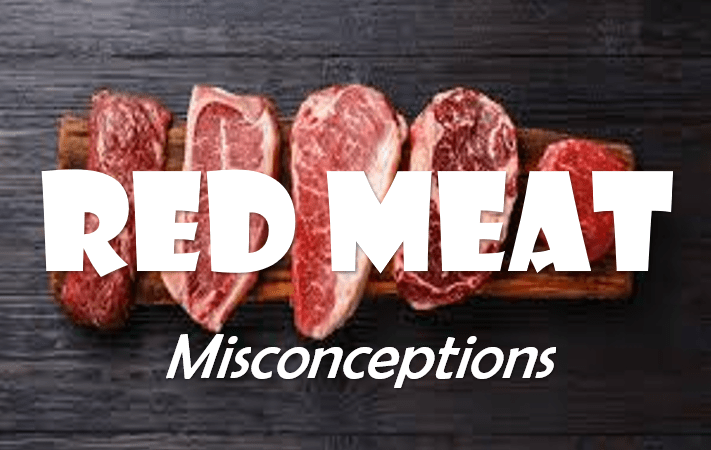By Cheyenne Dumont,
University of Saskatchewan Student
‘This gives you cancer’ or ‘that gives you autism’, are a few statements we hear far too often in today’s society. Where are people getting the information that causes them to think that these statements are true? Just a few months ago, I overheard someone saying that the red dyes in red meats are giving kids autism. Hearing this got me thinking about what I could do to prove that statement wrong and to also educate people on what is actually in our meat products and how it is all completely safe to consume.
Why is meat red?
Meat does not have red dyes injected in them at all. Meat is red due to a protein called myoglobin which is located in the tissue cells. Myoglobin gives off a purple colour until it interacts with oxygen. Once the myoglobin mixes with the oxygen, it changes to oxymyoglobin and the purple colour turns into a bright red. Some of the reddish tones also come from hemoglobin, a protein located in the red blood cells. Hemoglobin’s main job is to carry oxygen from the lungs to the body’s tissues. After animals are slaughtered there can still be some left-over hemoglobin in the meat which will account for the rest of the redness.
What is in my meat?
Though meats do have not red dyes added to them, they are still injected with other products. One of the main products that gets injected into our meat is Dihydrogen Monoxide. This might not sound too pleasant of an additive, but it is actually water! Dihydrogen Monoxide is the chemical name of the compound water. Water is also known as H2O, which means water is made up of two hydrogen atoms, and one oxygen atom. Many types of meat are injected with extra water to help make juicier meat and help keep flavours. Companies are only legally allowed to inject up to 5% of the product weight with water. If the companies inject more than 5% of the product weight with water they have to declare added water on the packaging.
Other additives we sometimes see on meat labels are natural or synthetic chemicals which help to preserve the meat. These chemicals include forms of antimicrobials and antioxidants. Antimicrobials are preservatives that help the meat last longer by slowing down the growth of mold, bacteria, and yeasts; which if consumed can cause food poisoning. Antioxidants help the meat by preventing the food molecules from combining with oxygen. When the molecules in meat interact with oxygen it causes the meat to lose its red colour and turn to a brown or grey colour. It is important to inject Antioxidants into our meat, so it can stay looking attractive for as long as possible. By using antimicrobials and antioxidants to preserve and keep the meat looking attractive, it is also helping to reduce food waste as the meat is able to last longer, while still looking fresh.
How can I be sure my meat is safe for consumption?
The thing is, meat cannot go on the market if it has any unsafe or harmful products or chemicals in it. Before meat goes on the market it has to be approved by the Canadian Food Inspection Agency (CFIA). Livestock is inspected after being killed for slaughter at inspection stations by the CFIA. The CFIA requires that slaughter establishments provide inspection stations to allow for a thorough inspection of the carcass and its parts. The inspection stations are very sanitary and are designed in a way that prevents contact between carcasses. If meat makes it onto the market, that means that the CFIA approved of the meat, and found it to be safe for consumption. Not only do meat products have to go through CFIA inspection, but it also has to go through different types of tests. These tests look at what has been injected into the meat, and what the levels of the injections are. If the levels are too high, the meat will not be sold on the market.
Conclusion
Far too often we hear people saying things like “this gives you cancer” or “that causes autism”. One of the first steps to take in changing people’s minds is by spreading the word and providing facts to prove that the foods they are blaming, are safe for consumption. Many people have targeted meat products saying it is not safe for consumption due to everything that is injected into it. Meat does have some injections in it like water to create juicer meats, and some natural or synthetic chemicals that help with preservation, but these chemicals are small doses and they are completely safe to consume. Before meat can go on the market it has to go through multiple tests to be sure it is safe and does not have any harmful chemicals or diseases in it. When you see meat in stores you can be sure it is all safe for consumption as every single meat product there has gone through tests to confirm its safety for all ages of consumers.
- Davis, Charles Patrick. “Hemoglobin Ranges: Normal, Symptoms of High and Low Levels.” MedicineNet, MedicineNet, 23 July 2019, https://www.medicinenet.com/hemoglobin/article.htm.
- Foodnavigator.com. “Survey Finds Branded Meat Products Pumped Full of Water.” Foodnavigator.com, William Reed Business Media Ltd., 27 Apr. 2005, https://www.foodnavigator.com/Article/2005/04/27/Survey-finds-branded-meat-products-pumped-full-of-water#.
- Government of Canada, Canadian Food Inspection Agency, and Food Import Export and Consumer Protection Directorate. “Archived – Meat and Poultry Products.” Meat and Poultry Products – Canadian Food Inspection Agency, 13 May 2019, http://www.inspection.gc.ca/food/archived-food-guidance/meat-and-poultry-products/eng/1300124955992/1300125034322.
- Government of Canada, Canadian Food Inspection Agency, and Food Safety and Consumer Protection Directorate. “Guidance on Canadian Food Inspection Agency Inspection Stations for Slaughter Operation of Food Animals and Meat Products.” Canadian Food Inspection Agency, 8 Apr. 2019, http://www.inspection.gc.ca/food/food-specific-requirements-and-guidance/meat-products-and-food-animals/cfia-stations-for-slaughter/eng/1550250803810/1550250952413#a3.
- Pal, Mahendra, and Mridula Devrani. “Application of Various Techniques for Meat Preservation.” OMICS International, OMICS International, 20 Jan. 2018, https://www.omicsonline.org/open-access/application-of-various-techniques-for-meat-preservation-2472-0542-1000134-97738.html.
- Rinzler, Carol Ann. “The Natural and Synthetic Nature of Food Additives.” Dummies, https://www.dummies.com/health/nutrition/natural-synthetic-nature-food-additives/.
- “The Color of Meat and Poultry.” The Color of Meat and Poultry, USDA, 6 Aug. 2013, https://www.fsis.usda.gov/wps/portal/fsis/topics/food-safety-education/get-answers/food-safety-fact-sheets/meat-preparation/the-color-of-meat-and-poultry/the-color-of-meat-and-poultry/ct_index.
- “What Is Water Made of?” DrinkTap.org, https://drinktap.org/Kids-Place/The-Story-Of-Drinking-Water/What-is-water-made-of.

Cheyenne Dumont
My name is Cheyenne Dumont and I come from Outlook, SK. I am currently taking Agribusiness through the University of Saskatchewan. When I graduate, I plan on working in the agriculture industry where I will be able to continue learning every day while spreading awareness on questioned topics in agriculture. In my spare time I enjoy doing anything outdoors or spending time with family and friends.



